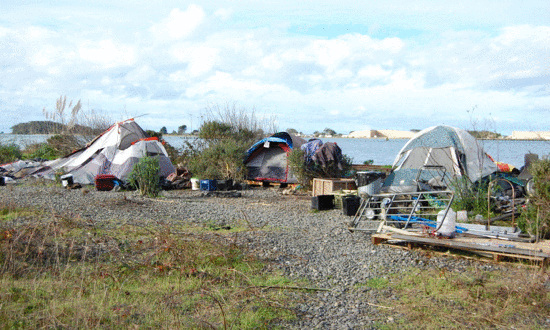File photo
More than 1,300 people were living homeless in Humboldt County on the night of Jan. 27, according to the latest point-in-time survey conducted by the Humboldt Housing and Homeless Coalition (HHHC). This year’s count of 1,319 people, including 32 children, reflected 265 more homeless people than the last time such a count was done, two years ago.
More than 30 local agencies and 100 volunteers spread out across the county in late January to find unhoused people and ask them their age, living situation and health status. These biennial surveys, conducted across the country, are required by the U.S. Department of Housing and Urban Development (HUD).
In a press release about the count (below), the Humboldt County Department of Health and Human Services notes that the survey is not scientific. (A comprehensive count would be virtually impossible.) But the numbers are intended to “provide a snapshot of our homeless on a specific night,” said Karen “Fox” Olson, executive director at Arcata House Partnership and co-chair of the HHHC.
Some interesting stats from the survey:
- More than half of the county’s homeless — 730 people, or 56.3 percent — were found in Eureka
- 844 people — more than 64 percent of those counted — were unsheltered the night of the count, meaning they were sleeping in a car or on a street, outdoors, or in an abandoned building
- Among those who had shelter that night, 28.6 percent stayed with friends or family, almost 12 percent stayed at the Rescue Mission, four people spent the night in jail and one spent it in the hospital
- Almost half the people surveyed reported a monthly income below $100; only 6 percent reported making more than $1,000 per month, down from 11.5 percent two years ago
- The percentage of respondents who reported having been released from jail in the previous six months nearly doubled since 2011, jumping from 11.5 percent to 21.6 percent
- Nearly 69 percent said they’ve been consistently homeless for more than a year
The complete report, which includes many interesting charts, can be found here.
Read the county’s press release below:
The 2015 homeless Point in Time (PIT) count report has been finalized, showing a total of 1,319 homeless, including 32 children—265 more homeless people than were counted during the 2013 PIT.
More than 30 agencies and 100 trained volunteers assisted in this year’s PIT count which showed Eureka having the county’s largest homeless population, followed by Arcata and Southern Humboldt.
The biennial PIT count, conducted by the Humboldt Housing and Homeless Coalition (HHHC), documents the number of sheltered and unsheltered homeless persons. The count takes place in communities across the U.S. on a single night in January. For Humboldt County, this year it was Jan. 27.
Starting the morning after and going through the week, volunteers connected with homeless people throughout the county to administer voluntary surveys with questions about age, physical and mental health status and where they had slept on the designated night.
“This year we had a lot of community interest and more volunteers participating in the count than in previous years,” said Barbara LaHaie, co-chair of the HHHC and assistant director, programs, for the Humboldt County Department of Health & Human Services (DHHS). “These numbers are so beneficial to the HHHC and assist us in determining how best to use our resources.”
The count is a U.S. Department of Housing and Urban Development (HUD) requirement. Information gathered during this count is used by local planning departments and by county nonprofit agencies in applications for grant funding and planning.
Although there are various definitions of homelessness, HUD’s definition includes the following four categories:
1. Individuals and families who lack a fixed, regular and adequate nighttime residence
2. Individuals and families who will imminently lose their primary nighttime residence
3. Unaccompanied youth and families with children and youth who are defined as homeless under other federal statutes who do not otherwise qualify as homeless under this definition
4. Individuals and families who are fleeing, or are attempting to flee, domestic violence, dating violence, sexual assault, stalking or other dangerous or life-threatening conditions that relate to violence against the individual or a family member.
People living with friends or relatives, as well as people staying in motels, are not considered homeless, per HUD’s definition.
The count is not scientific, but provides a picture of the homeless population at a specific point in time.
“It provides a snapshot of our homeless on a specific night,” said Karen “Fox” Olson, executive director at Arcata House Partnership and co-chair of the HHHC.
She said this year’s PIT was a success, which she credits to a few things.
“We simplified the survey, the volunteers were great and the California Center for Rural Policy (CCRP) at Humboldt State University analyzed the data and provided us with a final report. This year is the best data collection the HHHC has ever done.”
Olson said they also set up hubs throughout the county where homeless people could come and be interviewed, including the Arcata House Annex, Betty Kwan Chinn Day Center, North Coast Veterans Resource Center, Fortuna Adventist Community Services, Redwood Teen Challenge, Church of the Joyful Healer and WISH-Women’s Crisis Shelter In Southern Humboldt.
The 2015 PIT Count committee included the North Coast Veterans Resource Center, Arcata House Partnership, DHHS, Redwood Community Action Agency, Redwood Teen Challenge, the Humboldt County Office of Education and two at-large community members. The count was funded in part by First 5 Humboldt County, the North Coast Grant Making Partnership, St. Joseph Health System and the CCRP.
The HHHC is a coalition of housing advocates, businesses, funders, elected officials, service and housing providers, faith-based organizations and other community stakeholders working together to identify and address local housing needs. In Humboldt County, the HCCC is the lead organization for homeless issues and the federally designated Continuum of Care. For more information about the HHHC, visit its website at http://humboldthousing.org/about-the-hhhc/.

CLICK TO MANAGE